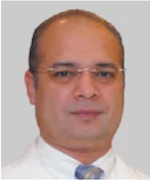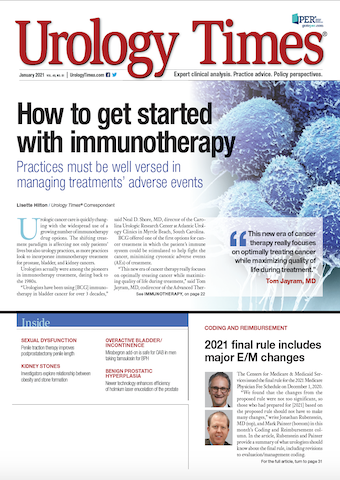Publication
Article
Urology Times Journal
Extended pelvic lymph node dissection during RP does not appear beneficial
Author(s):
The technique fails to demonstrate benefits for prostate cancer recurrence and metastases.
Badar M. Mian, MD

In “Journal Article of the Month," Badar M. Mian, MD, offers perspective on noteworthy research in the peer-reviewed literature. Dr. Mian is professor of surgery in the division of urology at Albany Medical College, New York.
Despite a paucity of high-quality evidence, extended pelvic lymph node dissection (EPLND) at the time of radical prostatectomy (RP) has been being recommended with increasing frequency over the last few years. Several retrospective studies have reported increased lymph node yield as well as increased detection of positive lymph nodes. However, the true extent of any therapeutic benefits of EPLND remains debatable. In a recently reported randomized study comparing limited pelvic lymphadenectomy (LPLND) and EPLND, Lestingi et al demonstrated that although EPLND may improve pathological staging, the oncological benefits remain unclear.1
The study enrolled 300 patients from May 2012 to December 2016, and randomly allocated 150 men to LPLND and 150 men to EPLND. The primary end point of interest was 5-year biochemical recurrence-free survival (BRFS). Secondary end points included metastasis-free survival (MFS), cancer-specific survival, and histopathological findings. The study was designed to detect a 15% improvement in 5-year BRFS in the EPLND group, assuming a 5-year BRFS rate of 65% for the LPLND group.
For the entire cohort, median age was 63 years and median prostate-specific antigen level was 10.5. Gleason grade group distribution showed 36% of patients were grade group (GG) 1, 40% GG 2, and 23% GG 3 to 5. Nearly 62% were classified as D’Amico intermediate-risk prostate cancer and 38% as high-risk prostate cancer. For the bilateral lymph node dissection, LPLND was confined to the obturator zone only while the EPLND included the obturator, external iliac, internal iliac, common iliac, and presacral regions.
After RP and pelvic lymphadenectomy, pathologic stage T3a or higher was noted in more than 60% of patients, and positive surgical margins were noted in 40%. The median number of nodes removed with LPLND and EPLND was 3 and 17, respectively (P<.001). Lymph node metastases were noted in 5 (3.4%) men in the LPLND group and in 25 (17%) men in the EPLND group (P<.001). In subgroup analysis of men with D’Amico intermediate-risk and high-risk prostate cancer, a higher lymph node metastases rate was noted with EPLND (11% and 26%, respectively) than with LPLND (0% and 11%). Of the 25 patients with lymph node metastases in the EPLND group, the most frequent sites included internal iliac (65%), external iliac (39%), and obturator (35%) lymph nodes.
The median follow-up for patients without biochemical recurrence was 53.9 months. No difference in BRFS was noted between EPLND and LPLND groups. The median BRFS was 61.4 months in the LPLND group, and it was not reached in the EPLND group (HR, 0.91; 95% CI, 0.63-1.32; P=0.6). Further, the median MFS was not reached in either group, and there were no differences between the 2 groups in terms of distant metastases or death. Salvage radiation therapy utilization was similar in both groups (32% in LPLND, 25% in EPLND). Androgen deprivation therapy was required in 18% and 14% of men in the LPLND group and the EPLND group, respectively.
In the subgroup of men with biopsy GG 3 to 5 undergoing EPLND, the BRFS was superior to men undergoing LPLND using both the intention-to-treat (HR, 0.33) and per-protocol analyses (HR, 0.48). Using Kaplan-Meier estimates, intention-to-treat analysis showed median BRFS at 12.34 months in the LPLND group and not reached in the EPLND group (HR, 0.48; P=0.02). However, in the per-protocol analysis, the median BRFS in the LPLND and EPLND groups was not statistically significant (19.9 months vs 32.7 months, respectively; HR, 0.79; P=0.4).
One of the limitations of the study is the somewhat short follow-up to assess survival outcomes; however, this follow-up may be acceptable for the early oncological outcome such as biochemical recurrence. Further, the complications associated with PLND were not reported and will likely be revealed in a follow-up manuscript. Although findings suggest that a subset of patients, such as those with Gleason GG 3 to 5, may benefit from EPLND, the number of subjects in each group was too small (LPLND, 38 men; EPLND, 31 men) to draw firm conclusions. The oncological benefit of EPLND in men with high-grade prostate cancer would require validation in a separate larger study.
Previous publications (typically observational or case-control studies) have variably reported some oncological benefit associated with EPLND but also increased risk of complications such as lymphocele formation, bleeding and increased operative time. The current study may represent the only study providing a high level of evidence about the oncologic benefits of EPLND at the time of RP. In this randomized trial, EPLND significantly improved lymph node staging but failed to demonstrate any overall benefit compared to LPLND in terms of biochemical recurrence or metastases.
While we await results of other trials, especially those including a larger number of men with biopsy GG 3 to 5, or high-risk prostate cancer, it appears that EPLND is unnecessary in most patients undergoing RP, with the possible exception of men with high-risk disease.
Reference
1. Lestingi JFP, Guglielmetti GB, Trinh Q-D, et al. Extended versus limited pelvic lymph node dissection during radical prostatectomy for intermediate- and high-risk prostate cancer: early oncological outcomes from a randomized phase 3 trial. Eur Urol. Published online December 5, 2020. doi:10.1016/j.eururo.2020.11.040























